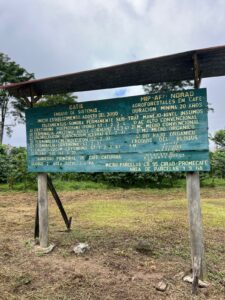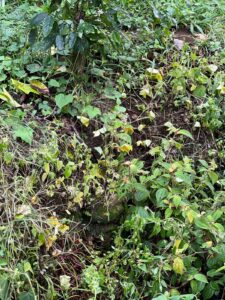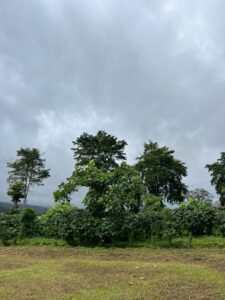Wrapping up my learning journey in Costa Rica, I visited CATIE (Tropical Agricultural Research and Higher Education Center). With a history spanning over 75 years, CATIE is the premier center for research and higher education in tropical agricultural systems. The institute serves as a cradle of research and knowledge for sustainable and regenerative solutions in agriculture, which are crucial for sustaining Latin America`s agriculture economies.
During my visit, I had the privilege of spending a day with Professor Elias de Melo Virginio Filho, who leads a 23-year research experiment on coffee. This experiment compares six different agroforestry designs with varying management approaches, ranging from intense organic to intense chemical methods, including the use of different tree species, as well as fully conventional production under direct sunlight.

Initiated in the 1990s, this experiment aimed to address a profound crisis affecting the coffee sector, particularly impacting farmers who faced plummeting market prices and bankruptcy. Professor Elias and his team of scientists set out to identify the most sustainable and productive agroforestry design, balancing factors such as sustainability, input usage, productivity, and plant health. The study involved collaboration with a large group of researchers from various fields and 22 universities, resulting in a wealth of scientific articles and research theses.
The first step was to select tree species commonly used in traditional Central American agroforestry systems, including shade trees that can also provide wood and species that fix nitrogen in the soil. The findings of the research are remarkable, challenging many myths prevalent in the global coffee industry and shedding light on why efforts to produce more sustainable coffee can sometimes fail.
One key finding, which is common knowledge in the scientific world but often disregarded in the industry, is that coffee trees are genetically predisposed to thrive in the presence of shade trees rather than under direct sunlight. This applies not only to robusta coffee, known for its shade-grown characteristics and lower quality, but also to arabica coffee, which is typically grown under direct sunlight for higher yields. Professor Elias’s 23-year research demonstrated that regenerative coffee production is not feasible without incorporating other tree species into the system. In contrast, monoculture coffee production under direct sunlight, despite high productivity achievable with heavy chemical inputs, fails to achieve soil balance and incurs increasing costs over time, ultimately proving unsustainable for coffee producers.

Another significant aspect of the study was the selection of coffee varieties for research within different agroforestry designs. The team primarily focused on the widely used Caturra variety, along with micro-plots of new hybrid plants selected for improved climate adaptability and resistance to pests. While some hybrids outperformed Caturra in the experiment, it was observed that transitioning from chemical to organic production without gradual reduction of chemical inputs and substitution with biological alternatives proved to be a costly endeavor, often requiring interventions and replanting. Systems employing a transition method with gradual reduction of chemical inputs and integration of shade trees that fix nitrogen demonstrated more stable coffee production and ecosystem services.

N-fixing species must also be managed with annual pruning of their crowns to incorporate large amounts of nutrients into the soil, in addition to improving other soil properties, particularly its biology. In this way, It contributed both with extra nutritional input to the coffee and the restoration of the soil, in addition to dynamically pruning its crowns, allowing the regulation of the shade levels needed for coffee in dry and rainy seasons.
The experiment also underscored the importance of regenerative practices, such as utilizing the right species of cover crops between coffee rows to enrich soil, maintain humidity, and provide soil shade without competing with coffee plants. However, the most significant finding came from the nitrogen-fixing properties of certain tree species. N-fixing trees that provide nutrients via pruned crown biomass play a regenerative role in the soil. Moreover, by improving the nutrition of coffee trees, they strengthen their responses to pests and diseases, making it possible to reduce the use of fertilizers and pesticides. Additionally, they can help enhance the quality of coffee. It is important to highlight that a single group of tree species does not fulfill multiple benefits. A good combination of species, as well as proper tree management, is key to success.

Agroforestry systems with high densities of trees, particularly species that compete for light and nutrients, can drastically affect yields in coffee production. Agroforestry systems that adequately combine N-fixing trees (with canopy management to incorporate green organic matter and regulate light) with good timber species densities allow for adequate coffee production while providing key environmental services such as the presence of pollinators and natural pest controllers, high carbon sequestration, water infiltration, etc. Based on what was learned in the long-term trial with types of Erythrina pruning, it can be anticipated, particularly in cases like Brazil, that the mechanized coffee harvest can be strategically facilitated in coffee plantations associated with leguminous trees, achieving various benefits for the crop area.

Regarding organic coffee, the experiment found that organic plots provided stable yields after the transition process, especially when integrated with nitrogen-fixing trees and a balanced shade environment. Notably, the experiment provided scientific evidence that coffee trees contribute to carbon sequestration, and balanced agroforestry systems can achieve carbon neutrality, warranting consideration for carbon credits to support agroforestry coffee initiatives.
We concluded our visit with a brief visit to Cafetalera Aquiares, Costa Rica’s largest coffee operation, which implements the agroforestry systems studied at CATIE. This farm serves as an exemplar of large-scale regenerative coffee production, with the successful hybrid coffee variety “Esperanza” symbolizing hope for resilient coffee cultivation amidst climate change challenges.
In closing, I am eager to expand collaboration with Professor Elias on our coffee farm in Brazil. Moreover, I anticipate returning to CATIE to explore research on regenerative solutions for cocoa, sugarcane, livestock production, and a myriad of tropical products, which could catalyze a transformative shift towards regenerative agriculture in the global south, significantly impacting our climate and biodiversity crises.
For a summary of CATIE’s coffee experiment and to learn more about CATIE’s research initiatives, please access the links provided below.

